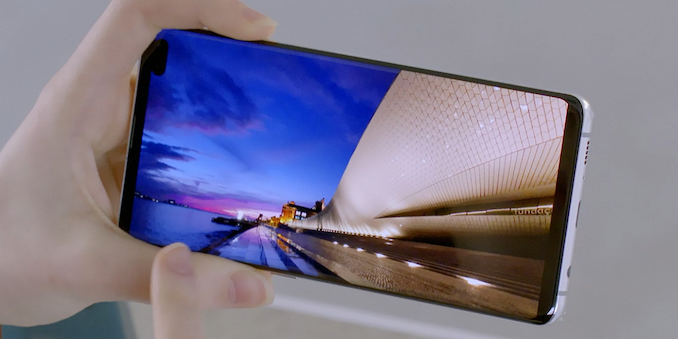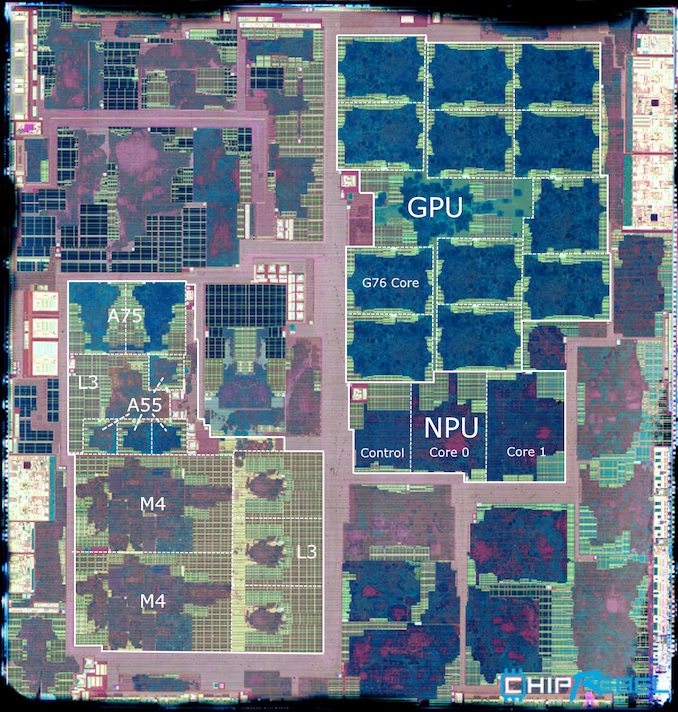ChipRebel Releases Exynos 9820 Die Shot: M4 CPUs in New Cluster
by Andrei Frumusanu on March 9, 2019 3:30 AM EST- Posted in
- Smartphones
- Samsung
- Mobile
- SoCs
- ChipRebel
- Exynos 9820

Every time a new SoC comes one, the one thing we eagerly await is for someone to release a die shot of the new chip. This process is most interesting when the new chip either comes with a new microarchitecture or a new process node. Last November, we covered the release of ChipRebel’s Kirin 980 die shot which gave us the first ever look of Arm’s new Cortex A76 CPU as well as Mali G76 GPU on a new 7nm process node.
The folks over there are at it again and have seemingly been very busy overnight, this time around tearing down the Galaxy S10 with the new Exynos 9820. I’ve been going back and forth with the ChipRebel team on these last two projects and they’re great guys, definitely visit them if you are in need of die shots.

Die shot: Chip Rebel - Annotations/labelling: Andrei @ AnandTech
8nm not as small as 7nm
The first thing standing out for the Exynos 9820 is the fact that at ~127mm², the chip has actually grown compared to the 10LPP Exynos 9810 of last year. Samsung’s 8LPP node isn’t as aggressive in scaling as TSMC’s 7nm process, and in theory the process node should bring a conservative 15% reduced area compared to its preceding node, leaving TSMC at a notable density advantage this generation. Compared to the Kirin 980 at 74.13mm², the Snapdragon 855 at 73.27mm² and even Apple’s A12 at 83.27mm², the new Exynos 9820 clearly stands out as out of line compared to the competition.
The Exynos 9820 also changes a lot internally, compared to the Exynos 9810 last year. First off we notice that the CPU cluster isn’t as prominent as it was last year. The reason for this is simply that Samsung opted to only employ two of its new generation M4 cores as opposed to the quad-core layout of the M3 in the 9810.
Interesting in the die shot is the new cluster layout: Next to the M4 cores we see now three L3 slices with a similar design as we saw in the 9810. However north of the two M4 cores we see a further L3 slice that differs from the other three. This slice seems to be the one that connects the new Cortex A55 and A75 cores to Samsung’s cluster.
I’ve had the Galaxy S10+ with the Exynos 9820 in-house since yesterday, and I can confirm that the L3 cache has remained at a total of 4MB, although I need a bit more time to figure out exactly how much of this is accessible by the Cortex cores as there’s power management policies coming into play.
The important thing to note here is that the Cortex A55 cores are no longer handicapped by not sharing the same higher level cache hierarchy as the rest of the CPU complex.
The new Exynos M4 cores clock up to 2.73GHz, the A75 cores at up to 2.31GHz and the A55 cores up to 1.95GHz.
On the GPU side of things, we still see Samsung dedicate a lot of area to the Mali G76MP12 – although it’s doesn’t look as big as last year’s G72MP18.
Finally, below the GPU, we find Samsung’s new NPU. This is a dual-core design running at up to 933MHz and offering up to 1.9TOPs at 8-bit precision, although Samsung looks to be counting 6.9TOPs in quantised models. Samsung themselves publish the die area of this block to be 5.5mm².
We thank the guys at ChipRebel for sharing this die shot with the public as it offers great analysis of Samsung’s new chip! On our side, we have the S10+ in-house now and I’ll be working on the full detailed device+SoC review.










66 Comments
View All Comments
FunBunny2 - Monday, March 11, 2019 - link
" Huawei's playing the nationalism card by pretending that piecing together ARM cores equate to creating "China's own SoC" "not to be too jingoist, but isn't that what Apple did? and any other 'architecture licensee'?
MykeM - Monday, March 11, 2019 - link
It should be noted Apple's history with ARM began long before the iPhone. In fact, ARM (the company) began as joint venture between Acorn Computers (where it all began), Apple Computers (later Apple Inc) and VLSI Technology:A bit of ARM history:
https://community.arm.com/developer/ip-products/pr...
Plus Apple designed its own core beginning with the A6 (late 2012) using ARMv7 (Swift) and then ARMv8 (Cyclone, Typhoon, Twister, Hurricane/Zephyr, Monsoon/Mistral and Vortex/Tempest).
Huawei uses ARM Cortex cores (like A76/A55 in the Kirin 980). Just like Qualcomm in the last couple of years.
pcslide - Wednesday, March 13, 2019 - link
Although I am sicken with the overwhelming media manipulations by HuaWei over the Internet. I have to say building up an competitive Soc for flagship mobile phones is not an easy task for today's market. Even though they use ARM's core as building blocks, they still need to overcome a lot of difficulties in engineering to pull this off. And it is very clear from HuaWei's product roadmap, what they want to achieve is way more bigger than what you claimed they did. The experience they got from building the Soc will lay the ground for their upcoming datacenter and cloud computing product. I have to say HuaWei is playing this on a much larger scale and on a different level. I believe if they can execute their plan nicely, they can be a major player not only in networking but computing as well in the next 10 years and has revenue equals Intel, Qualcomm, Nokia and Cisco combined.close - Monday, March 11, 2019 - link
No, being dependent on a third party that doesn't have any incentive to give you any say in anything is undesirable. Companies that can afford to (a handful as you can see) fix the issue by internalizing. It's the only way to have control over the product.tuxRoller - Sunday, March 10, 2019 - link
From techinsights (https://techinsights.com/about-techinsights/overvi... for the exynos9820 the soc/bom≈ 17% (about $70).tuxRoller - Sunday, March 10, 2019 - link
For reference, the most expensive component is the display @ 86.50, or ≈ 21%.Those two components represent 1/3-2/5 of the bom.
s.yu - Sunday, March 10, 2019 - link
It's as I thought the moment I saw the 9820 announced on the 8nm node, but the preliminary numbers still suggest a significant performance gap despite investing in a much larger die.Javert89 - Saturday, March 9, 2019 - link
It will be interesting to see if they release Exynos 9825 with 7nm LPE for Note 10.. Double as much area as competitors is a lotJavert89 - Saturday, March 9, 2019 - link
It's a lot of GPU cores though.. Wonder if the solution is equivalent or superior to Adreno 640 in efficiency (node size apart)s.yu - Sunday, March 10, 2019 - link
Highly unlikely, Adrenos have been ahead of Malis(regardless of core count) for many generations.